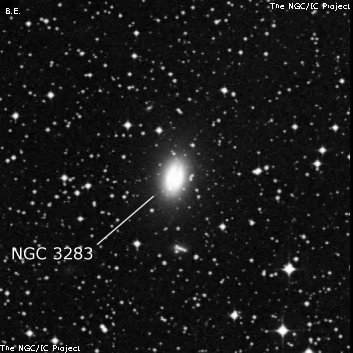
John Herschel discovered NGC 3283 = h3271 on 3 Mar 1837 and recorded "pF, S, R, gbM, 25". RA coarsely taken by an auxiliary star". The given position (updated to 2000 coordinates) is 10 32 47 (approximate), -46 15 14. JH also made a 10' error in declination (too far north) in the GC, which was copied into NGC.
ESO couldn't find a suitable candidate and RNGC classifies the number as nonexistent. But assuming the RA was rough, I looked at ESO galaxies and found a likely candidate ESO 263-G48 located at 10 31 11.5 -46 15 05 (J2000). This galaxy is 1.6 tmin preceding JH's rough RA and a nearly perfect match in declination. It is also fairly bright (V = 11.5), so it's unlikely it would have been missed in his sweep. Both NED and HyperLeda use this identification.
400/500mm - 18" (4/6/16 - Coonabarabran, 236x): fairly bright, moderately large, elongated 3:2 N-S, 1.2'x0.8'. Contains a relatively large, bright core surrounded by a low surface brightness halo, elongated N-S. Located 6.9' SE of mag 8.8 HD 91215 and 6' S of a mag 10.1/10.4 pair at 5". Located in a rich star field. ESO 263-047, an extremely low surface brightness galaxy 7' WSW, was highly suspected as a very small patch attached to a faint star.
Notes by Steve Gottlieb